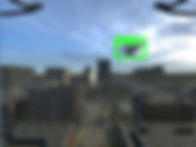Our technology enables first responder teams to learn faster and safer complex tasks.

Virtual Reality (VR) technologies seem to be increasingly popular in various industries.
By definition, VR is a computer generated 3D environment where people can immerse themselves and interact with it. They are presented with a version of created reality that isn’t really there, but from their perspective, it is perceived as real.
That’s why VR is widely deployed in simulation solutions: It offers incredibly high fidelity of the real world at considerably lower costs compared to real-world exercises.

By leveraging the Unreal 3D game engine, Humanitas creates a high-fidelity VR simulation ecosystem. A large set of accurate built-in sensors, actuators and robot models are either developed or optimized based on data collected from real sensors, Computational Fluid Dynamics (CFD) analysis, and wind tunnel tests.
Moreover, hardware-in-the-loop (HIL), software-in-the-loop (SIL) and Drone-in-the-loop (DIL) paradigms are also included in the simulation platform to support the collaborative design, testing, validation and certification of drone swarming technology.


Apart from accelerating development and testing, the VR simulator is also a perfect source for dataset generation, which will then be used for training and testing AI algorithms.

A dedicated Reinforcement Learning Engine is built within the simulator for such purposes, helping to train and progress the intelligence of swarms.





Moreover, the simulator can also serve for mission-critical operator training purposes. They can wear VR headsets and immerse themselves in serious games reflecting real-world scenarios. These special emergency scenarios are particularly tailored not only for operator training but also for AI training in complex situations through a trial and error approach.
Simulation Solution

